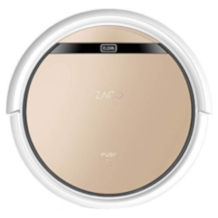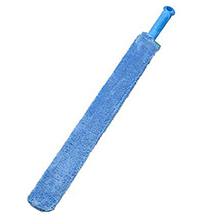Mop purchasing advice: how to choose the right product
- The most important facts in brief
- Floor mops come in various forms: from the familiar bucket set with a spinning or wringing mechanism to the mop with a spray function.
- The combination of a spin mechanism, intuitive operation and the widest possible mop head proves to be particularly effective for cleaning floors.
- Pay attention to the characteristics of the respective floor covering. Tiles, laminate and parquet each have different cleaning requirements.
Convenient cleaning thanks to floor mops
After mopping the floor is known to be before mopping the floor: No sooner have you mopped than you could be cleaning the floors again. Whether dog or cat paws, rubber boots or a dropped drinking cup – there are plenty of reasons why cleaning should be as quick and convenient as possible. With the floor mop, the name says it all. Laminate and tiles can be cleaned quickly and easily with this practical household helper. It usually consists of a mop head, optionally covered with a cover or pad, and a long handle. In addition to these simple mops and flat mops, there are also electric steam brooms or mops.
Whichever you prefer, floor mops are more efficient than the combination of mops and scrubbing brushes. What’s more, they are more environmentally friendly than damp floor cloths, as there is significantly less waste. Many covers can be washed in the washing machine and used again and again – which also saves money.
What types of floor mops are there?
There are two types of classic manual floor mops: Flat mops, which are covered with a rectangular cotton or microfibre cloth, and fringed mops, usually round and with several long fringes between which coarse dirt and hair collect. Which type of floor mop is best for you depends on your floors.
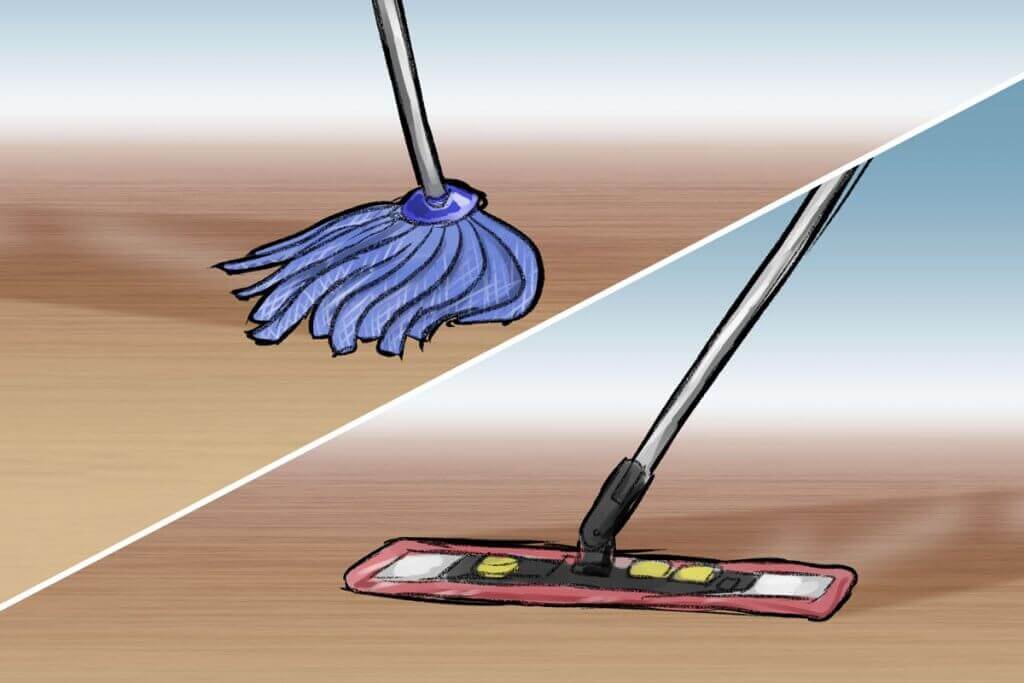
Fringed mop
In contrast to the flat mop, the fringed mop is characterised by a round mop head with a fringed cover. Hair and dirt easily get caught in this. During floor cleaning, it can be rinsed out and wringed out in the mop bucket. If the mop system has an appropriate mechanism, the mop can also be conveniently squeezed out in a kind of sieve or spun out in a drum. Some mops have a removable, washable cover.
The advantage of the mop is its fringed cover: it allows you to reach corners of the room and wipe comfortably around furniture or other obstacles. However, due to its significantly smaller width, it is less suitable for large floor areas. There are even some fringed covers for flat mops.
Pro points
- Efficient dirt trapping in the fringes
- Mostly suitable for washing machines
- Convenient wringing out or spinning out with some systems
Drawbacks
- Not suitable for large areas due to narrow width
Flat mop
A characteristic feature of flat mops is the long, flat mop head. It has different widths and is therefore suitable for different sized surfaces. It usually has a replaceable, sometimes reusable cover that can be cleaned at 60 degrees Celsius in the washing machine. This is attached to the mop head via clamps or press studs. The alternative is damp disposable cloths that are thrown away after wiping. However, they are not environmentally friendly and are often not compatible with the systems mentioned above.
The advantage of the flat mop is its optimised design for cleaning large areas, which it owes to its working width. However, it shows weaknesses in cleaning performance especially in corners. Niches and furniture can also become a challenge for it.
Pro points
- Time-saving cleaning of larger areas
- Usually machine washable
Drawbacks
- No good cleaning performance in room corners or on furniture edges
What you should look for when buying a floor mop
There is a wide range of floor mops available. To find the right model from this selection, you should pay attention to the following points, including the handle length, the material, the width of the mop head, the cleaning performance, the cover, extras such as a bucket with a special function or a spray function, and the product weight.
It’s the length that counts
Floor mops are popular because they make cleaning floors easier and are easy on the back. However, the handle needs to be long enough so that you don’t have to bend down. Some models have a telescopic handle so you can adjust them to your height. This way, you don’t have to buy several mops so that all the housemates can help clean.
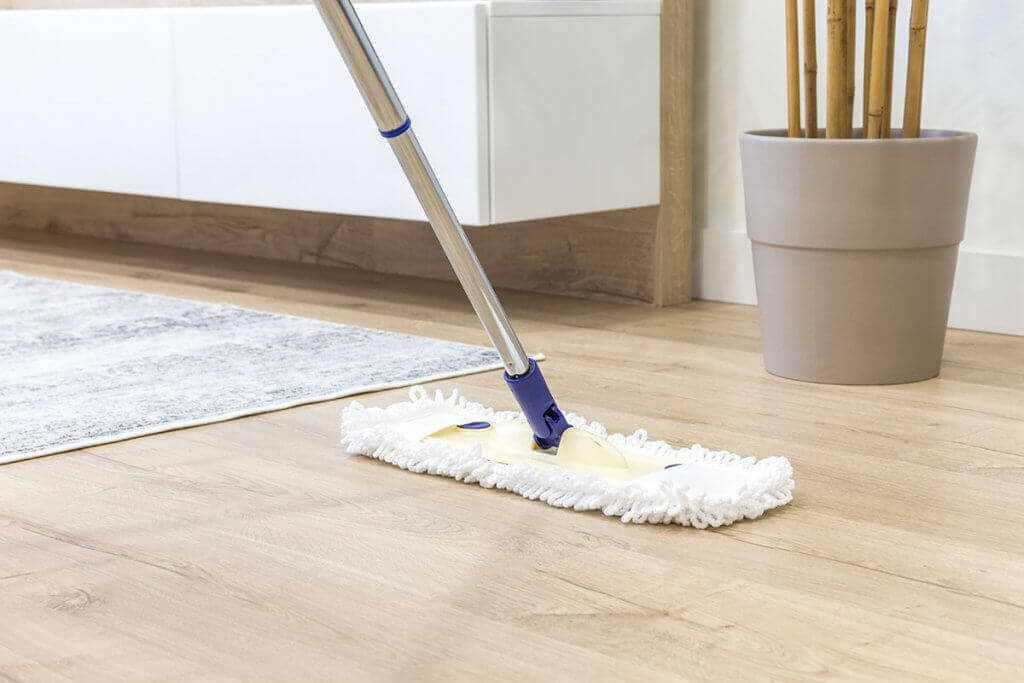
What material should the mop be made of?
The mops are often fibre blends of cotton and microfibre. Such mixed materials are suitable for most surfaces. Even with varnished parquet, the use of mop attachments with microfibre content is not a problem. The situation is different with oiled wooden floors: They are susceptible to scratches and small cuts caused by worn microfibres. On these surfaces you should use pure cotton attachments and not too much water.
Width of the mop head
The width of the mop head determines how many passes you have to make with the wet cleaner over the floor to make everything shine. The following applies: The mop head of a flat mop is always wider than that of a mop. But there are also differences between the individual types. Especially with flat mops, the width of the mop head can vary greatly, for example between 25 and 45 centimetres.
Cleaning performance
The cleaning performance of the floor mop is of course influenced by the type of mop. The width of the mop head also has an influence. Almost more important, however, is the material of the cover. Microfibre, for example, picks up much more dirt than a cover made of pure cotton. From time to time, some floors can even be cleaned entirely without detergent, i.e. only with a microfibre cover. This applies, for example, to the absorption of house dust. The higher the quality of the cover, the more water it absorbs when soaked in the bucket and only releases it gradually when mopping. This way, puddles do not form and you are not constantly busy mopping up the water instead of cleaning the floor. As a rule, these are covers with a cotton and microfibre content.
Advantage of washable covers
If the floor mop is suitable for use with reusable covers, this has several advantages: First and foremost, of course, are sustainability and environmental protection. A washable cover is cleaned in the washing machine and can then be reused as normal. This reduces waste and saves money.
Of course, you can also use disposable cloths. These are usually already damp, so you don’t need to fill a bucket with water. This makes disposable covers ideal for quick, short cleaning in between. For large floor areas, however, they quickly become unwieldy, as you need a lot of them for one cleaning cycle. In addition, the systems are usually not compatible with each other, so that the disposable or reusable cloths do not last on “foreign” floor mop systems.
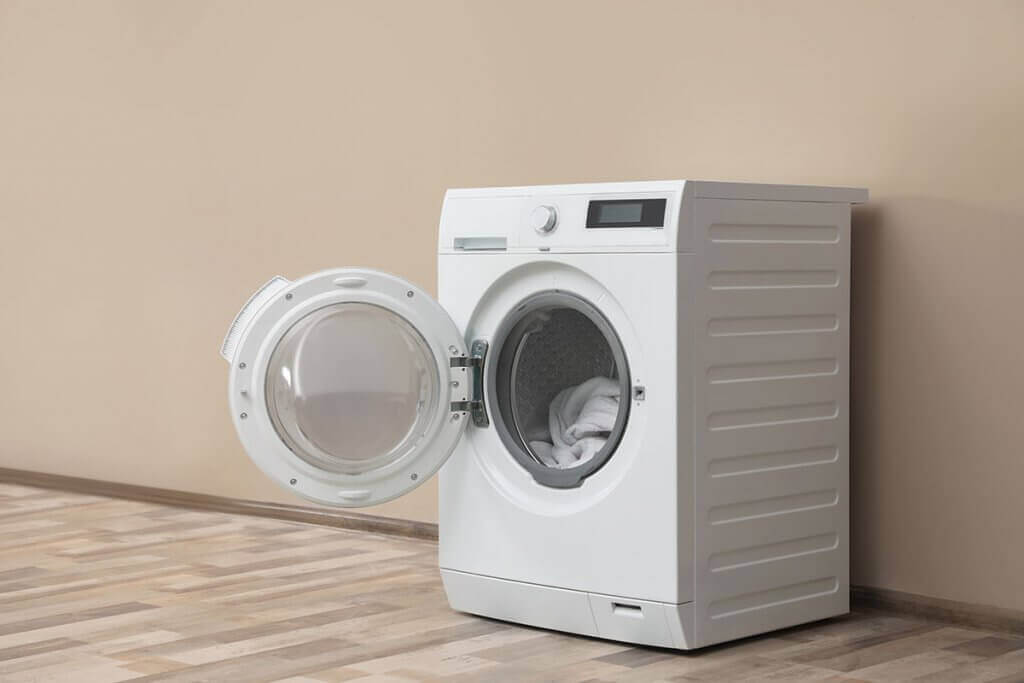
Bucket with wringing or spinning function?
When using a floor mop, it makes sense to use a bucket. This way you can clean the cover without having to run to the sink every time. The bucket contains the cleaning water and some detergent. Some floor mop sets also come with a mechanism to wring out or spin the cover. While some buckets have a mechanical press that forces excess water out of the cover, other models have a small pedal on the side that triggers the spinning of the mop head, forcing excess water out of the cover by centrifugal force. No matter which of the two functions you prefer, your hands will stay dry in any case. In addition, you can determine relatively easily how damp the mop cover should be. This is a decisive advantage, especially for floor coverings that are sensitive to moisture.
Floor mops with spray function
Floor mops with a spray function are the alternative to mops with a bucket. Here, the cleaning water is in a small bottle on the handle of the floor mop. You can spray some cleaning solution onto the floor in front of the mop head using a button or switch on the handle of the mop. Then you wipe over it normally.
With these floor mops, you use comparatively little cleaning water. The humidity can also be set very precisely. This makes the mops particularly suitable for water-sensitive floor coverings. However, their cleaning performance is often significantly lower than that of floor mops with buckets.
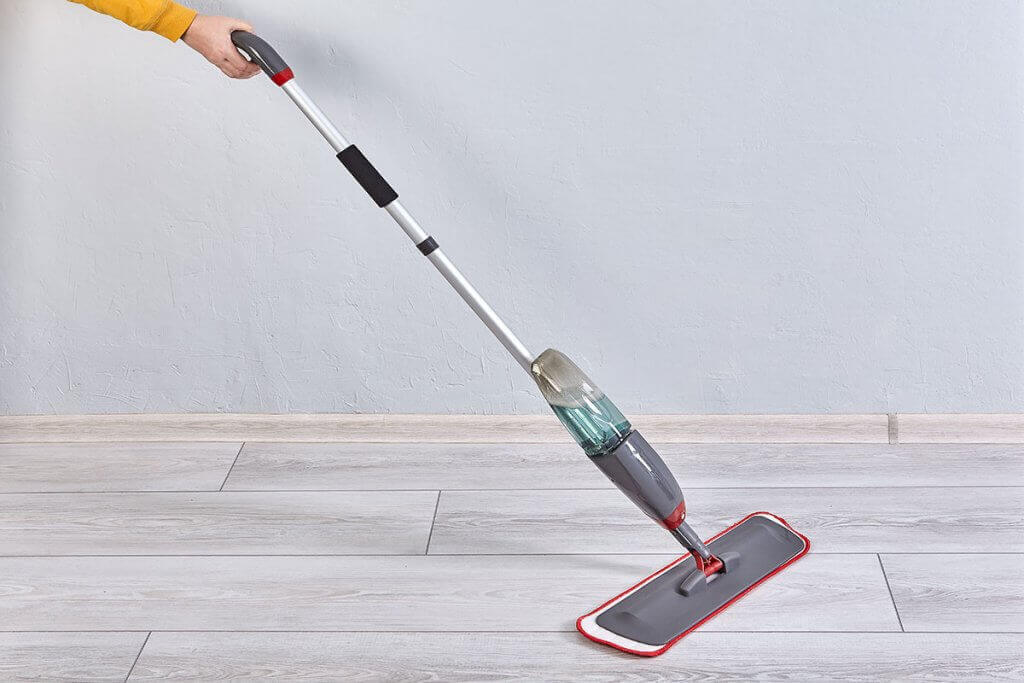
How much does a floor mop weigh?
Floor mops are used throughout the entire flat or house. This means that you do not only mop one floor, but also have to carry the floor mop up the stairs to the next floor. Depending on how often or how far you have to carry the floor mop, its weight becomes noticeable. We will leave the weight of the water in the mop bucket out of the equation. As a rule, floor mops weigh less than one kilogram. Then there is the bucket, including water and detergent, and potentially a wringing aid. Some models weigh only about 750 grams. A comparison is worthwhile here, especially if you are looking for a light but robust floor mop.
Tips and tricks for a clean floor
Different floor coverings such as tiles, laminate and parquet have different cleaning requirements. Therefore, it is important to know how you should handle which floor.
Good preparation: the basis of a clean floor
Not only dust and hair collect on the floor, but also other dirt such as soil residues, abrasion from soles or paw prints. So the first thing to do is to tidy up. Collect toys, shoes and anything else that may still be lying on the floor. If possible, put chairs up high so that you don’t have to move them to the side later when mopping.
Then first go over the floor with the hoover. This removes loose dirt and hair that would later get caught in the mop cover. Only then do the actual mopping. Be careful not to use too much water. Wooden floors and laminate in particular can only tolerate a little moisture. If necessary, simply wipe again with a dry cover; this way, no moisture remains.

The right cleaning agent
The choice of cleaning agents is almost as varied as the range of floor mops. All-purpose cleaners are the most common – after all, they promise an all-round attack on various types of dirt and grease: they are good for cleaning floors in the living room, kitchen and bathroom. If you don’t have an all-purpose cleaner in the house or if you want to save money, you can take a look in the household cupboard. You can often find simple cleaning solutions there.
Vinegar: This is a true all-rounder when it comes to cleaning. Simply dilute vinegar or vinegar essence with water and then use it to mop smooth floors. Vinegar is so powerful that it even removes limescale residue.
Washing-up liquid: Probably everyone has washing-up liquid at home. It dissolves dirt as well as many floor cleaners and is much cheaper.
Fabric softener: You wonder how your neighbour gets his laminate so shiny? Maybe he just adds a little fabric softener to the mopping water.
Curd soap: This household remedy is the perfect choice for cleaning tiles. Curd soap can also remove stubborn dirt or heavy encrustations. Soften it with a little soap and water. Afterwards, they can be easily removed with a plastic spatula. After wiping, however, you should wipe again with clear water.
Alternatives to manual floor mops
If the floor is very dirty, you can consider buying a steam cleaner. It heats water and emits hot steam, which soaks the dirt without chemicals and makes it much easier to remove. When you mop after the steam treatment, you pick up the dirt and get a shiny, hygienic floor as a result. A steam broom combines these two steps. And with a hard floor cleaner, you save yourself the trouble of preparing the floor with a hoover: the device combines vacuuming and mopping in one step.

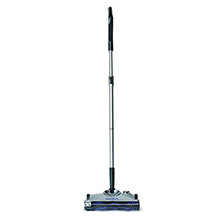
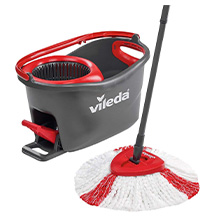
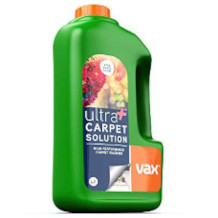
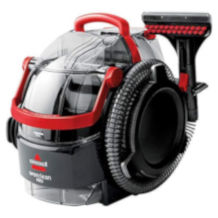
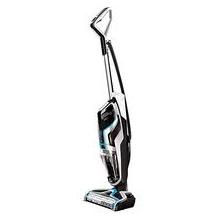
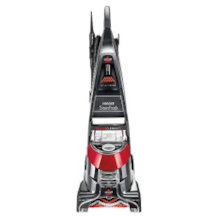
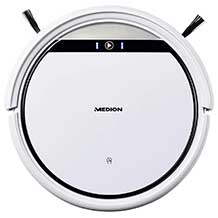
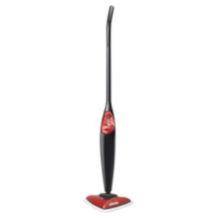
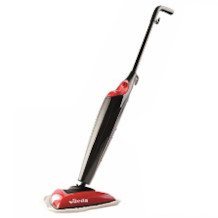

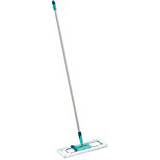
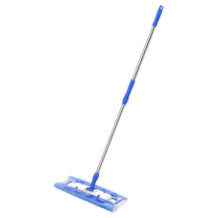
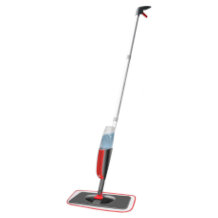
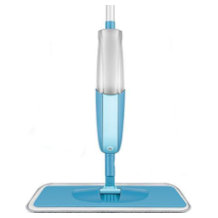
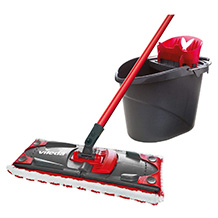
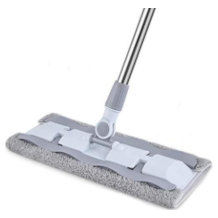
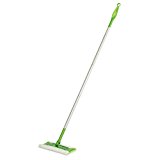
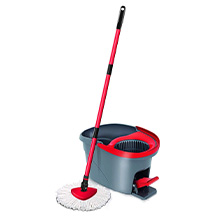

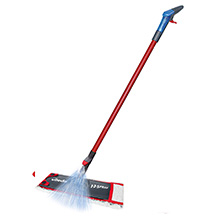

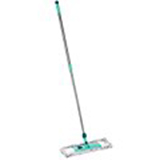

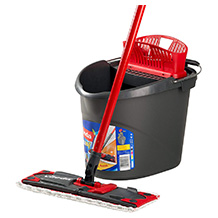
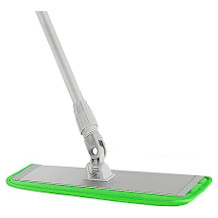


 2,641 reviews
2,641 reviews

